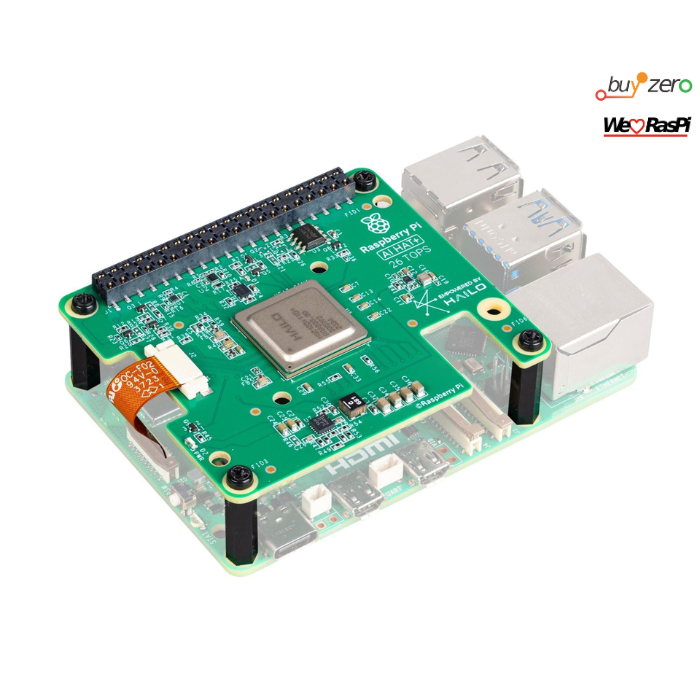Imagine turning your Raspberry Pi 5 into a self-contained AI powerhouse for tasks like home automation, robotics, or real-time video analytics. That’s exactly what the Raspberry Pi AI HAT+ offers. Built around a Hailo AI accelerator, this add-on board significantly boosts your Pi’s capabilities, enabling you to run neural networks locally - without relying on cloud services.
In this post, we’ll walk you through the core features of the AI HAT+, explain essential concepts like TOPS, compare it to other accelerators, and show you three quick examples to jump-start your AI projects on the Pi 5.
Concept Explanation
What Is TOPS?
TOPS (Tera Operations Per Second) is a metric indicating how many trillion operations an AI chip can handle per second. While TOPS is a useful benchmark for raw performance, practical throughput also depends on factors like memory bandwidth, software optimizations, and thermal limits.
Why Use an AI HAT+ on the Pi 5?
The Raspberry Pi AI HAT+ taps into the Pi 5’s PCIe Gen 3 interface, providing a direct high-speed connection to the on-board Hailo accelerator. This setup allows:
- Low-latency processing for tasks such as object detection and image segmentation.
- Energy-efficient operation, with a wide range of potential applications in security, process control, and automation.
The Raspberry Pi AI HAT+
Key Features
-
Performance Variants:
- 13 TOPS using the Hailo-8L accelerator (ideal for moderate workloads).
- 26 TOPS using the Hailo-8 accelerator (better suited for heavier or multiple neural networks).
- Framework Compatibility: Runs with common AI frameworks like TensorFlow and PyTorch.
-
Camera Integration: Links seamlessly with Pi cameras, enabling advanced post-processing (object detection, segmentation, pose estimation) through the built-in
rpicam-apps. - Operating Temperature: 0°C to 50°C (ambient).
- Production Lifetime: Guaranteed availability until at least January 2030.
Comparing the AI HAT+ to Coral AI
Other edge AI accelerators like Google Coral are also popular. While Coral often provides 4–8 TOPS modules, the AI HAT+ can reach 13 or 26 TOPS, depending on which Hailo chip you choose. However, raw performance should be balanced against factors such as:
- Ease of integration (the Pi 5’s new PCIe Gen 3 connection).
- Supported software libraries (Hailo’s drivers vs. Coral’s Edge TPU tools).
- Thermals and power requirements.
Technical Specifications at a Glance
- Accelerator Options: Hailo-8L (13 TOPS) or Hailo-8 (26 TOPS).
- Form Factor: Conforms to the Raspberry Pi HAT+ spec.
- PCIe Gen 3 Interface: Enables high-bandwidth communication.
- Included: 16mm stacking header, spacers, screws, and a ribbon cable to link to Pi 5’s PCIe port.
- Temperature Range: 0°C to 50°C.
- System Requirements: Raspberry Pi 5 running an up-to-date Raspberry Pi OS (64-bit Bookworm recommended).
Three Easy Examples to Get Started
Below are three quick demos using the built-in rpicam-apps. Each demo makes use of a camera feed (either the CSI camera or an official Pi camera) and leverages the AI HAT+ for real-time inference.
You will need:
- Raspberry Pi 5
- a Raspberry Pi AI HAT or Raspberry Pi AI HAT+
- 64-bit Raspberry Pi OS Bookworm install
- any official Raspberry Pi camera (e.g. Camera Module 3 or High Quality Camera)
Example 1: Verify Installation & Hello AI HAT+
-
Install the Latest OS and Firmware on your Pi
sudo apt update && sudo apt full-upgrade sudo rpi-eeprom-update -a sudo reboot -
Attach the AI HAT+
- Power down your Pi 5.
- Fit the AI HAT+ using the provided spacers and ribbon cable to the Pi’s PCIe port.
- Power the Pi 5 on again.
-
Install Dependencies
sudo apt install hailo-all -
Check the Device
hailortcli fw-control identifyIf you see device info and firmware version details, your AI HAT+ is ready to go!
Example 2: Object Detection Demo
-
Install rpicam-apps
sudo apt update && sudo apt install rpicam-apps -
Run YOLOv6 Inference
rpicam-hello -t 0 --post-process-file /usr/share/rpi-camera-assets/hailo_yolov6_inference.jsonThe camera feed opens, and bounding boxes highlight detected objects in real time.
-
Experiment with Other Models
- Try YOLOv8:
rpicam-hello -t 0 --post-process-file /usr/share/rpi-camera-assets/hailo_yolov8_inference.json - YOLOv5 Person & Face:
rpicam-hello -t 0 --post-process-file /usr/share/rpi-camera-assets/hailo_yolov5_personface.json
Each model offers different trade-offs in speed vs. accuracy.
- Try YOLOv8:
Example 3: Pose Estimation
-
Launch the Pose Demo
rpicam-hello -t 0 --post-process-file /usr/share/rpi-camera-assets/hailo_yolov8_pose.json -
Observe the Output
- The camera preview displays 17-point pose estimations, drawing lines between key joints.
- Useful for applications like fitness tracking or robotics.
FAQ
-
Which Raspberry Pi 5 models are supported?
Any official Pi 5 board. Just ensure you have the HAT+ connectors and the correct OS version. -
Does the AI HAT+ require a fan or heatsink?
For most workloads, passive cooling may suffice, but heavy neural network tasks or high ambient temperatures might benefit from an active cooler. -
How do I switch between 13 TOPS and 26 TOPS variants?
You must purchase the corresponding HAT+ model. The Pi detects the attached Hailo chip automatically. -
Which frameworks are compatible?
Popular frameworks like TensorFlow, PyTorch, and ONNX-based models are supported through the HailoRT middleware. -
Will existing Pi camera software work?
Yes. The AI HAT+ integrates seamlessly with rpicam-apps, which automatically uses the onboard Hailo accelerator for supported post-processing tasks.
Further Resources
- HAILO - Official site for additional documentation and downloads.
- Raspberry Pi OS Documentation - Detailed instructions on Pi setup and software updates.
- Hailo RPi5 Examples - Community and official demos.
- Pi Forums - A great place to ask for help or share ideas.
- Contact Us - If you have any questions, don't hesitate to write us!
The Raspberry Pi AI HAT+ offers a straightforward, cost-effective path to high-performance edge AI on the Pi 5. By leveraging the built-in Hailo accelerator and the Pi 5’s PCIe Gen 3 interface, you can handle tasks like object detection, image segmentation, and pose estimation - all in real time.
Next Steps:
- Explore the rpicam-apps demos to dive deeper.
- Join the Pi and Hailo communities for hands-on tips.
- Experiment with different models and frameworks to find the perfect fit for your project.
We’d love to learn more about your project and help you select the most suitable models and accelerators. We are your navigator in the vast landscape of edge AI acceleration. Reach out to us today to discuss your requirements and let us guide you toward the optimal edge AI solution.

